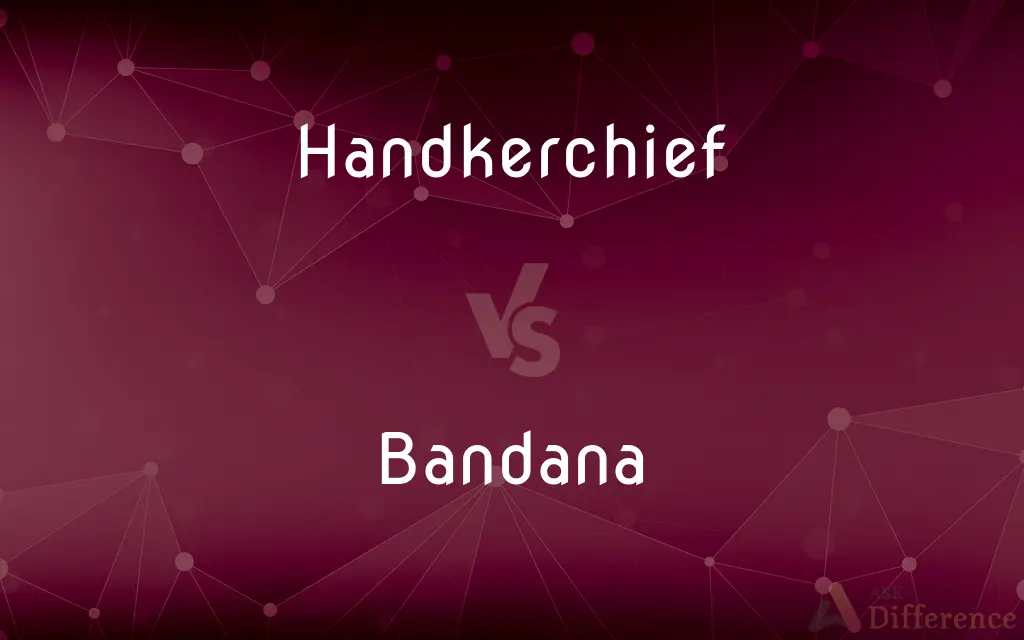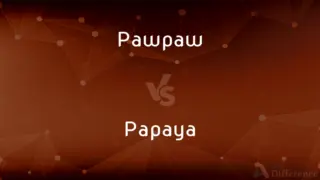Handkerchief vs. Bandana — What's the Difference?
By Tayyaba Rehman — Updated on November 5, 2023
Handkerchief is a small square of cloth used for personal hygiene, while a bandana is a larger piece of fabric, often colorful and worn on the head or neck.

Difference Between Handkerchief and Bandana
Table of Contents
ADVERTISEMENT
Key Differences
In the realm of personal accessories, handkerchiefs and bandanas serve distinct purposes despite their similar cloth construction. A handkerchief is traditionally a small, square piece of fabric, typically made from cotton or linen, and is designed for personal hygiene such as wiping one’s hands or face. In contrast, a bandana is a larger, more versatile piece of cloth, often made of a light, handkerchief-like material but can also be found in silk or polyester. Bandanas are known for their colorful patterns and are used as a fashionable head or neck accessory, or for practical purposes such as protection from dust.
When it comes to social symbolism, both handkerchiefs and bandanas have held varied meanings over time. A handkerchief might have once signified a person's social status, especially when it was finely made and perhaps monogrammed. Meanwhile, the bandana has been imbued with cultural significance, at times associated with certain groups or movements, such as cowboys, gangs, or even political statements. Despite these associations, today both are seen as functional items with a potential fashion statement.
Historically, the use of the handkerchief dates back centuries and was a staple in both men’s and women’s wardrobes. Bandanas also have a rich history, originally derived from the Hindi word 'bandhana,' meaning 'to tie,' referring to the method of dyeing and tying cloth. Although bandanas and handkerchiefs can be similar in fabric and pattern, the handkerchief remains primarily a practical, personal hygiene item, while the bandana has evolved into a versatile accessory used in various ways around the world.
In terms of global influence, both handkerchiefs and bandanas have left their mark. The handkerchief has seen a decline in everyday use with the advent of disposable tissues, but remains a classic accessory, particularly in formal settings. Bandanas, conversely, have surged in popularity across the globe, not just as a functional tool for workers but also as a statement piece in fashion circles, capable of being styled in numerous ways.
Comparison Chart
Size
Smaller, typically a square shape.
Larger, can also be square or triangular.
ADVERTISEMENT
Primary Use
Personal hygiene, wiping sweat or a nose.
Worn as a head or neck accessory.
Material
Often cotton, linen, or silk.
Cotton, polyester, or silk.
Cultural Significance
Less significant, more utilitarian.
Strong cultural associations.
Variability
Less varied in use.
Very versatile in use and style.
Patterns and Colors
Generally plainer, may have monograms.
Often colorful with various patterns.
Historical Origin
European origins in the medieval period.
Originated from Hindi ‘bandhana’.
Compare with Definitions
Handkerchief
A small square cloth used for personal hygiene.
She dabbed at her eyes with a lace-trimmed handkerchief.
Bandana
A large colorful kerchief often worn on the head or neck.
She tied a red bandana around her head before starting the hike.
Handkerchief
A practical tool for cleanliness.
After sneezing, he reached for his handkerchief.
Bandana
A fashion accessory that adds flair to casual attire.
He wore a bandana around his wrist at the music festival.
Handkerchief
A classic accessory for formal attire.
He folded a white handkerchief into his suit pocket.
Bandana
A utilitarian cloth for protection against dust and sun.
She wrapped a bandana over her face while riding through the desert.
Handkerchief
A keepsake often scented or embroidered.
Her grandmother left her an embroidered handkerchief as a memento.
Bandana
An improvised item for various emergency needs.
He used his bandana to bandage the wound temporarily.
Handkerchief
An item used in traditional magic tricks.
The magician pulled a colorful handkerchief from his sleeve.
Bandana
A symbolic garment associated with various subcultures.
The bikers sported bandanas to signify their club colors.
Handkerchief
A handkerchief (; also called a hankie or, historically, a handkercher) is a form of a kerchief or bandanna, typically a hemmed square of thin fabric which can be carried in the pocket or handbag, and which is intended for personal hygiene purposes such as wiping one's hands or face, or blowing one's nose. A handkerchief is also sometimes used as a purely decorative accessory in a suit pocket; it is then called a pocket square.
Bandana
A large handkerchief usually patterned and brightly colored.
Handkerchief
A square of cotton or other finely woven material intended for wiping one's nose.
Bandana
A large kerchief, usually colourful and used either as headgear or as a handkerchief, neckerchief, bikini, or sweatband.
Handkerchief
A small square of cloth used especially for wiping the nose or mouth.
Bandana
A style of calico printing, in which white or bright spots are produced upon cloth previously dyed a uniform red or dark colour, by discharging portions of the color by chemical means, while the rest of the cloth is under pressure.
Handkerchief
A large piece of cloth worn as a decorative article; a scarf.
Bandana
Large and brightly colored handkerchief; often used as a neckerchief
Handkerchief
A piece of cloth, usually square and often fine and elegant, carried for wiping the face, eyes, nose or hands.
Handkerchief
A piece of cloth shaped like a handkerchief to be worn about the neck; a neckerchief or neckcloth.
Handkerchief
A piece of cloth, usually square and often fine and elegant, carried for wiping the face or hands.
Handkerchief
A piece of cloth shaped like a handkerchief to be worn about the neck; a neckerchief; a neckcloth.
Handkerchief
A square piece of cloth used for wiping the eyes or nose or as a costume accessory
Common Curiosities
What is the primary use of a handkerchief?
The primary use of a handkerchief is for personal hygiene, such as wiping hands or the face.
Is there a difference in size between a handkerchief and a bandana?
Yes, handkerchiefs are generally smaller than bandanas.
Are bandanas associated with any cultural movements?
Yes, bandanas have been associated with cowboys, gangs, and political statements.
What's the historical origin of the handkerchief?
The handkerchief has European origins dating back to the medieval period.
Why might someone choose a handkerchief over disposable tissues?
For environmental reasons, or as a stylish accessory.
Are handkerchiefs still in fashion?
Handkerchiefs are less common but remain a classic accessory, especially in formal attire.
Can a bandana be used as a handkerchief?
Yes, a bandana can be used as a handkerchief but it is typically larger and more decorative.
Are handkerchiefs typically patterned or plain?
Handkerchiefs can be both but are often plainer or have monograms.
Is a handkerchief considered a luxury item?
It can be, especially when made from fine materials like silk.
Can bandanas be personalized?
Yes, bandanas can be personalized with various colors and patterns.
Are there gender-specific styles for handkerchiefs and bandanas?
No, both are unisex, though certain patterns may be marketed toward specific genders.
What are common materials for bandanas?
Bandanas are commonly made from cotton, polyester, or silk.
Can bandanas serve a practical purpose besides fashion?
Yes, they can protect against sun and dust, and be used for first aid.
How do you wear a bandana as a fashion statement?
Bandanas can be worn around the neck, head, wrist, or even as a top.
Do bandanas come in different shapes?
Traditionally square, but they can also be found in triangular shapes.
Share Your Discovery

Previous Comparison
Keyboard vs. Monitor
Next Comparison
Pawpaw vs. PapayaAuthor Spotlight
Written by
Tayyaba RehmanTayyaba Rehman is a distinguished writer, currently serving as a primary contributor to askdifference.com. As a researcher in semantics and etymology, Tayyaba's passion for the complexity of languages and their distinctions has found a perfect home on the platform. Tayyaba delves into the intricacies of language, distinguishing between commonly confused words and phrases, thereby providing clarity for readers worldwide.













































